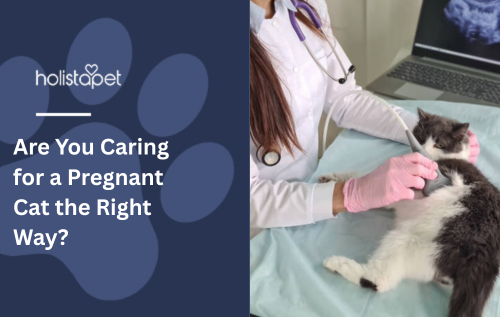Pregnancy in cats can be a beautiful but delicate time. Whether you're a first-time cat owner or have an expecting queen under your care, understanding pregnant cat care is essential to ensure a safe, healthy journey for both the mother and her kittens.
In this guide, we’ll cover the signs of cat pregnancy, what to feed her, how to prepare for delivery, and common mistakes to avoid.
 Understanding Cat Pregnancy: What to Expect
Understanding Cat Pregnancy: What to Expect
Cats (also called queens during pregnancy) have a gestation period of around 63–67 days. During this time, their nutritional, emotional, and physical needs change rapidly.
Early Signs Your Cat Might Be Pregnant
-
Nipple enlargement and darkening (often called "pinking up")
-
Increased appetite and weight gain
-
More affectionate or nesting behavior
-
Decreased activity or morning sickness
If you suspect pregnancy, a vet visit can confirm it through ultrasound or physical exam.
Pregnant Cat Care: A Week-by-Week Breakdown
Weeks 1–3: Gentle Observation
-
Keep her stress-free and avoid unnecessary handling.
-
Switch to a high-quality kitten food to begin boosting her nutrition.
Weeks 4–6: Nutrition & Comfort
-
Feed smaller, more frequent meals.
-
Keep her indoors to protect her from accidents and stress.
-
Start providing a quiet, warm nesting area.
Weeks 7–9: Prepare for Birth
-
Monitor her behavior—look for nesting, restlessness, or hiding.
-
Place clean bedding in a quiet box or laundry basket.
-
Avoid flea treatments or medications unless approved by a vet.
Common Mistakes to Avoid
-
Feeding regular adult cat food (not enough nutrients for growing kittens)
-
Allowing outdoor access (risk of injury, infection, or hidden birth)
-
Ignoring signs of distress (heavy panting, bleeding, or lack of appetite near due date)
 Frequently Asked Questions
Frequently Asked Questions
How many kittens can a cat have?
A healthy queen usually gives birth to 3–5 kittens, though it can range from 1–9 depending on her age and health.
Can I touch a pregnant cat’s belly?
Yes, but with care. Gentle handling is fine, but avoid pressing too hard. Overhandling may stress her or harm the kittens.
When should I take her to the vet?
-
Right after noticing signs of pregnancy
-
If she stops eating for more than 24 hours
-
If labor lasts more than 6 hours without producing kittens
What should I do if my cat gives birth at night?
Most cats deliver at night. Prepare a quiet, warm space ahead of time. Avoid interfering unless there’s clear distress, then call your vet.
Final Thoughts
Caring for a pregnant cat takes patience, observation, and a lot of love. From providing the right food to preparing a safe birthing space, your attentiveness can ensure her journey to motherhood is smooth and safe.
If you’re ever unsure, don’t hesitate to consult your vet—pregnancy is not the time for guesswork.
Helpful Notes
-
Always keep fresh water nearby.
-
Avoid giving raw food or treats not meant for pregnant/nursing cats.
-
After birth, continue feeding kitten food while she’s nursing.
Want to ensure your pregnant cat gets the best care possible? Bookmark this guide and share it with other pet parents!


 CBD Oil for Cats - Fast Acting
CBD Oil for Cats - Fast Acting
 CBD Cat Treats - Easy Dose
CBD Cat Treats - Easy Dose
 CBD Calming Chews for Cats - Highly Rated
CBD Calming Chews for Cats - Highly Rated
 CBG Oil for Dogs and Cats - Loved by Thousands
CBG Oil for Dogs and Cats - Loved by Thousands





Leave a comment
This site is protected by hCaptcha and the hCaptcha Privacy Policy and Terms of Service apply.